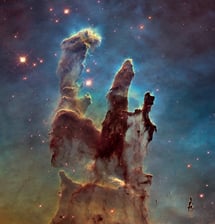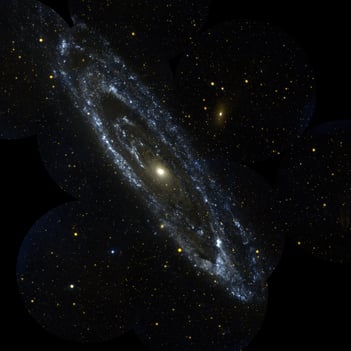Did you know telescopes are time machines? Not actually, as cool as that would be, but they DO look at the past. The way a telescope works is that light from a celestial object is gathered and magnified into an eyepiece that you then look into. That light had to travel from the object, all the way across space, then to your eye.
To our knowledge, nothing can travel faster than light; however, it is not instant. And space is quite large. The term light year is often used to describe the distance between many space objects. A light year is the distance light is able to travel in one year. It is the same as thinking in miles per hour but on a much larger scale. One light year is 5,878,625,373,183 miles.
 If we were to look at the nearest star to our solar system, Proxima Centauri, we would be looking at a star 4.3 light years away. The light that we see is 4.3 years old by the time it reaches us. We are seeing 2016 Proxima Centauri. And that is something that is “close” to us. The Eagle Nebula, more commonly the Pillars of Creation, is 7000 light years away. That would be like looking at Earth 5000 BCE, about the time of early development of Mesopotamia. One step further, the Andromeda Galaxy, is the nearest galaxy to our own Milky Way Galaxy. Andromeda is 2.5 million light years away, and if you are in a dark enough place you can see it with only your eyes, no telescope required. This is the time that the early hominins, homo habilis, had evolved. The earliest homo sapiens are dated back around 300 thousand years ago.
If we were to look at the nearest star to our solar system, Proxima Centauri, we would be looking at a star 4.3 light years away. The light that we see is 4.3 years old by the time it reaches us. We are seeing 2016 Proxima Centauri. And that is something that is “close” to us. The Eagle Nebula, more commonly the Pillars of Creation, is 7000 light years away. That would be like looking at Earth 5000 BCE, about the time of early development of Mesopotamia. One step further, the Andromeda Galaxy, is the nearest galaxy to our own Milky Way Galaxy. Andromeda is 2.5 million light years away, and if you are in a dark enough place you can see it with only your eyes, no telescope required. This is the time that the early hominins, homo habilis, had evolved. The earliest homo sapiens are dated back around 300 thousand years ago.
When we look through a telescope, we are seeing the objects as they were sometimes millions of years ago. Some of the light that is hitting our eyes left its home before the first use of controlled fire, estimated at 1.7 million years ago.
UAT is passionate about space, in fact, Professor Nathan Eskue is an excellent resource for space enthusiasts, with 20 years of aerospace/defense industry experience, including work for NASA, Raytheon, and Northrop Grumman.
Find out more about Professor Eskue and the rest of UAT's distinguished faculty at https://www.uat.edu/featured-technology-university-faculty.
Photo credits:
NASA/JPL/California Institute of Technology
NASA, ESA and the Hubble Heritage Team (STScI/AURA)
References:
https://en.wikipedia.org/wiki/Homo_sapiens
https://en.wikipedia.org/wiki/Homo_habilis
http://math.ucr.edu/home/baez/timeline.html
https://earthsky.org/clusters-nebulae-galaxies/andromeda-galaxy-closest-spiral-to-milky-way
https://en.wikipedia.org/wiki/Timeline_of_human_prehistory
https://en.wikipedia.org/wiki/Mesopotamia
https://www.universetoday.com/45003/how-far-is-a-light-year/
https://www.nasa.gov/image-feature/the-pillars-of-creation
https://www.jpl.nasa.gov/spaceimages/details.php?id=PIA04921




Comment